The last time Chrysler fielded a fully competitive midsize sedan was...a long time ago. The 2015 200, though, looks promising, with attractive styling, European underpinnings, a wide range of available features, and competitive pricing. Once driven, how does it measure up?
Both cars I drove had the V6 engine, the relatively luxurious 200C with front-wheel-drive and the sportier 200S with all-wheel-drive. The latter has only a few direct competitors: the Ford Fusion, Buick Regal, Subaru Legacy, and Volkswagen CC. I'll focus comparisons on the Ford here. The Buick will soon receive its own review. The Legacy will be reviewed once it is also redesigned for the 2015 model year.
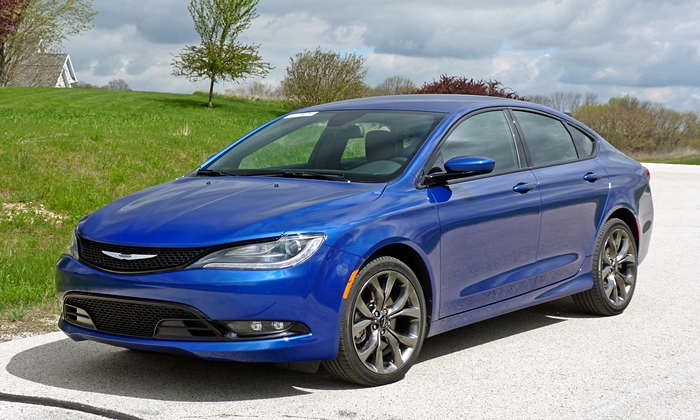
The new 200 is more attractive in S form, especially with blue paint and 19-inch wheels. more 200 photos
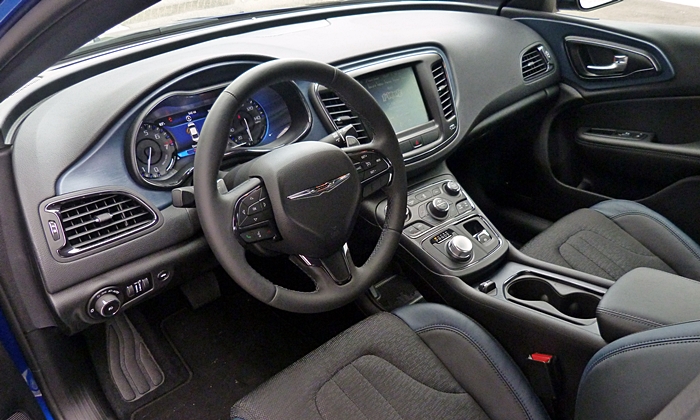
Black with blue accents in the 200S.
| |
Compared to the Fusion |
| Interior styling |
 Better
Worse
Better
Worse
|
Despite an overly short wheelbase (and an overly long nose) for its length, the 2015 Chrysler 200's exterior is fairly attractive, even striking from the right angle in the right color (blue works) and with the right wheels (avoid the base 17-inchers). But both the Ford Fusion and Mazda6 have similar shapes, so while the new 200 is a huge aesthetic improvement over the old one it doesn't appear nearly as fresh as it would have two years ago.
The standout styling is inside the sedan. Like the exterior, the interior borrows more than a few details from Audi, plus a pinch of Jaguar. Textured real wood trim is available in the 200C. Would the center stack appear cleaner and more upscale without the chrome trim rings? Perhaps.
Only the seat bolsters are leather with the 200S's standard interior, but the cloth center panels are both sporty and attractive. Personally, I wouldn't spend another $995 for full leather seating surfaces (unless I also wanted the ventilated seats or power passenger seat, both also included in this price).
Given the Chrysler's pricing, and the brand's repositioning in the thick of the market (rather than slightly upscale), its interior materials aren't nearly as nice as those inside an Audi or a Jaguar. They're generally a match for those inside direct competitors except for the knobs and buttons, some of which feel cheap.
The Fusion's interior materials have a more consistently high quality look and feel. But its interior is less dramatically styled, and in Titanium trim it is only offered in black.
| Controls and instruments |
 Better
Worse
Better
Worse
|
Those knobs and buttons might feel cheap, but they're very well laid out. No one matches Chrysler's controls for ease of use lately. In the new 200, Chrysler's usual control module is even easier to reach thanks to a sloped center stack (likely inspired by the Audi A8).
The Fusion's MyFord Touch system is notoriously difficult to operate (though it has been getting better).
The Chrysler does have one primary control not everyone will like. As in the latest Jaguars and Land Rovers, a console-mounted knob takes the place of the shift lever.
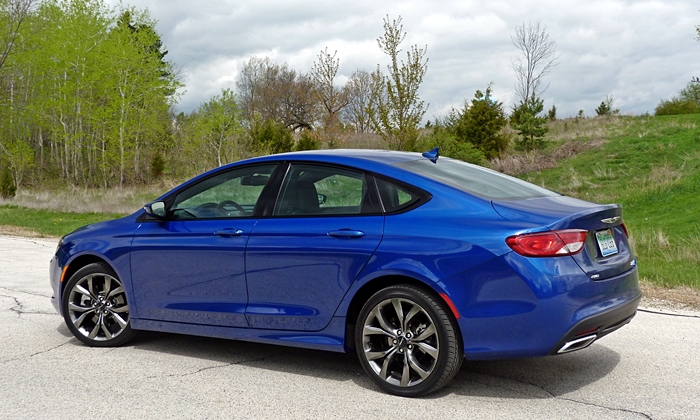
Probably the 200's best angle.
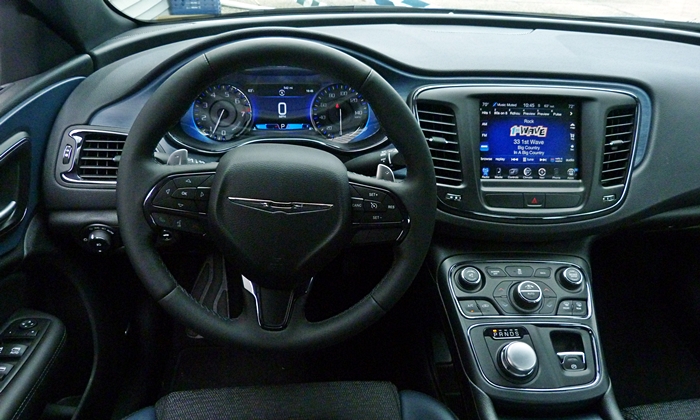
Larger display for top-level infotainment system.
| Feature availability |
 Better
Worse
Better
Worse
|
If a feature is available elsewhere in the segment, it's likely offered in the 2015 Chrysler 200. Proximity key, remote start, xenon headlights, cooled front seats, heated steering wheel, full-speed adaptive cruise control, and a complete array of electronic safety aids are yours if you check all the boxes. On the 200C. Most of these things aren't available on the 200S.
| Powertrain performance |
 Better
Worse
Better
Worse
|
With a base curb weight of 3,473 pounds, the 2015 Chrysler 200 is the heaviest car in the midsize sedan class. Add the V6 and all-wheel-drive, and it weighs nearly two tons--very heavy for a mainstream midsize sedan.
Luckily the 3.6-liter V6 is the strongest engine in the class, with 295 horsepower to the Ford turbo four's 240. Plus it's paired with a nine-speed automatic transmission which can deal out shorter initial ratios than competitors' six-speed automatics. Some competitors are about as quick, even a bit quicker, but the 200 is in the running. And the V6 sounds far better than any turbo four can hope to.
With the V6 and front-wheel-drive, the the steering wheel pulls a little this way and that under hard acceleration. All-wheel-drive eliminates this torque steer.
The standard 2.4-liter four-cylinder engine can only churn out 184 horsepower, but performed fairly well in the related, nearly as hefty Dodge Dart. So if you feel no need for strong acceleration or all-wheel traction, it should be viable.
Update: In response to owner and reviewer complaints, Chrysler has repeatedly updated the programming for the nine-speed transmission. Though still not the smoothest or most responsive transmission, I had few issues with it during my week with a 2016 200S. One issue I did experience: sometimes when attempting to pull out of a parking lot onto a busy road the powertrain would hesitate for what probably wasn't as long a moment as it felt.
| Price or payments |
 Better
Worse
Better
Worse
|
The old 200 sold largely based on price. After discounts and incentives it tended to be far cheaper than other midsize sedans. The new 200 looks and drives much better than the old one, yet it's list price is about the same when adjusted for its additional features. While the new car won't have to sell largely based on price, its price is among the reasons to buy it.
If you want a powerful all-wheel-drive midsize sedan, the Chrysler 200S and Subaru Legacy 3.6R are your only options with a price under $30,000--$29,690, to be precise. (Yes, Chrysler base-priced the 200S exactly even with the Subaru.) A Ford Fusion Titanium AWD lists for $3,600 more. Nearly all of the price difference can be attributed to the Ford's additional standard content. But not everyone wants this additional content, and Chrysler doesn't force you to buy it to get all-wheel-drive.
Chrysler has also priced the 200's options very reasonably. Add both available option packages to the 200S, and its price rises to $31,980. A Fusion Titanium AWD with nav lists for $2,110 more, about half of this due to feature differences.
Check all the boxes, and a Chrysler 200C lists for $37,860. This might seem like a lot, but a fully loaded Ford Fusion Titanium lists for $39,485--and includes significantly less content. Xenon headlights, a panoramic sunroof, laminated front door glass, and real wood trim aren't offered on the Ford, perhaps because they want people who desire these features to step up to the related, considerably more expensive Lincoln MKZ.
Except for the Subaru Legacy, Japanese competitors (including the Honda Accord) tend to be more expensive than the 200. The Hyundai Sonata and Kia Optima cost about the same as the 200 after adjusting for equipment differences.
Both the Buick Regal GS and the Volkswagen CC VR6 cost over $7,000 more.
| |
Compared to the Fusion |
| Rear seat room & comfort |
|
The Chrysler 200 shares its basic structure with the compact Dodge Dart. This basis is most evident in the back seat, where legroom is decent but hiproom is considerably tighter than in most midsize sedans. Thanks to the stylish roof line, rear headroom is also in short supply.
The Fusion's rear seat isn't nearly the roomiest in the class, but it is roomier and more comfortable than the Chrysler's. If you need a truly roomy rear seat and all-wheel-drive in a somewhat affordable midsize sedan, buy the Legacy.
| Fuel economy |
 Better
Worse
Better
Worse
|
The nine-speed automatic can largely compensate for the Chrysler 200's hefty curb weight on the highway, but the laws of physics are less easily circumvented in city and suburban driving. With the four-cylinder engine, the 200 manages a competitive EPA highway rating of 36, but a middling EPA city rating of 23. The class-leading Mazda6 and Nissan Altima rate 26/38 and 27/38, respectively.
Add the V6 and AWD, and the 200's 18/29 EPA ratings are well short of the Fusion AWD's 22/31, but are roughly even with the Regal GS's 19/27 and better than the Subaru Legacy's 18/25 and the Volkswagen CC's 17/25.
Update: In my real-world testing of a 200S V6 with AWD, the trip computer reported suburban averages in the 18 to 23 mpg range and 31 on a 70-mph highway. The transmission will shift to 9th only over 70 mph.

Chrome trim pieces replaced by black on the 200S.
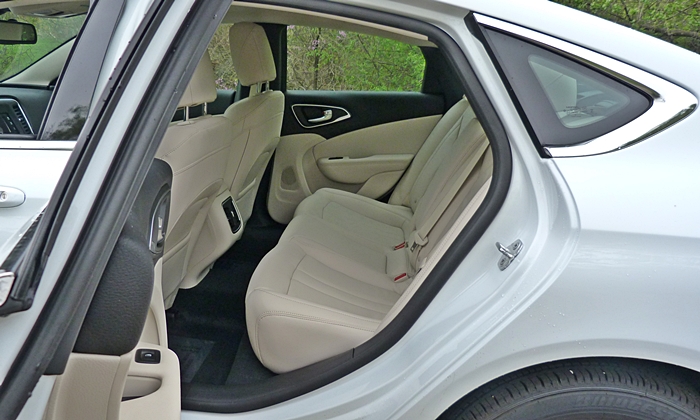
The weakest aspect of the new Chrysler 200.
| |
Compared to the Fusion |
| Front seat support & comfort |
 Better
Worse
Better
Worse
|
The 2015 Chrysler 200's front seat is roomier than its back seat, with about as much shoulder room as you'll find in the class. The seats themselves initially feel cushier than most. The front seats in the S have larger side bolsters, but even these are too soft and are spaced too widely to provide much lateral support. The headrest sometimes felt too far forward for my comfort, but my build is more upright than most. This probably won't be a problem for you, but check during your test drive.
| Cargo capacity |
 Better
Worse
Better
Worse
|
Then 200's trunk, at 16 cubic feet, is close is size to those of all major competitors. The rear seats fold.
The 200 does have an especially large storage compartment beneath a sliding cover in its center console.
| Ride smoothness |
 Better
Worse
Better
Worse
|
Like the Ford Fusion's, the Chrysler 200's suspension tuning is fairly firm, especially in the S, yet it rides smoothly, with good control over body motions, if not plushly. Though the interior is usually quiet, some road surfaces overcome the 200's sound insulation.
Update: when I tested a 2016 200S V6 with AWD for a week the ride sometimes felt bumpy.
| Handling |
 Better
Worse
Better
Worse
|
Given the cars' similar suspension tuning, both the Chrysler 200 and the Ford Fusion also lead the midsize sedan class in handling. Unless you want a midsize sedan that feels light and lively--then the Mazda6 tops them both. The 200 changes directions like the heavy car it is. (Granted, if you want a thoroughly involving car, then you should be shopping in a different class.)
Both cars feel more agile and balanced without their largest, most powerful engines in the nose. The 200 with the V6, like the Fusion with any engine other than the 1.6 turbo, feels a little nose-heavy.
The 200 has some handling advantages over the Fusion. You don't sit quite as low, and the depth of its instrument panel is much better disguised through clever design, so the view forward seems more open. The suspension of the 200S is tuned a little more aggressively than that in the Fusion, which offers no sport suspension. Chrysler's all-wheel-drive system (also used in the new Jeep Cherokee) is more sophisticated than Ford's. It's capable of shunting a larger percentage of torque to the rear wheels, for hints of oversteer in hard turns. When hustled along a winding road (or even around a racing circuit), the 200 maintains its composure far better than the average family sedan. Add in the throaty V6, and the experience can be more than a little fun. Just be ready for some torque steer if you get the V6 without all-wheel-drive.
But the Chrysler's quick steering is also overly heavy (especially in S mode, which reduces assistance a smidge), yet it doesn't feel as direct or as natural as the system in the Ford. Plus for those of us without large hands the 200's steering wheel rim is far too thick.
This section was added in March 2016. Through the end of 2015 the Chrysler 200 was scoring well in our car reliability survey (latest stats). But quite a few owners have been complaining about the nine-speed automatic transmission, not only in the 200 and in the related Jeep Cherokee but also in some Acuras. So far these complaints usually have been resolved through software updates, or not at all. If Chrysler eventually has to replace parts in many more cars, then the reliability score for the car will worsen. It's still far too soon to see how reliable this new transmission will be in the long term.
It's no easy task, getting people to consider a midsize sedan other than the Honda Accord and Toyota Camry. Chrysler's strategy is to offer more dramatic styling, more features (including all-wheel-drive), and sportier chassis tuning (especially in the 200S) at a lower price. It's not a new strategy. Ford pursued a similar one with the 2013 Fusion, and hasn't fared badly with it. But, given that the 200 and Fusion are much more similar than they are different, will Chrysler steal customers from Asian competitors, mostly from its cross-town rival, or from neither?
The new Chrysler 200 doesn't score many clear wins, but it does score a few, and is competitive (or better) in most aspects. Those seeking a roomy appliance will continue to gravitate towards the Asian brands. But anyone who puts a priority on styling, handling, or high-tech features, and who doesn't need the roomiest rear seat, should take a look at both the 200 and the Fusion. Picking one over the other often will come down to personal impressions of things like styling, seat comfort, the ease of using the controls--even the thickness of the steering wheel rim. So make that look a close one.
Then again, given all of the flack the Fusion's MyFord Touch interface has received, together with all of the praise for how the Ford looks and drives, maybe a similar car with much better controls is all the 200 needs to be.
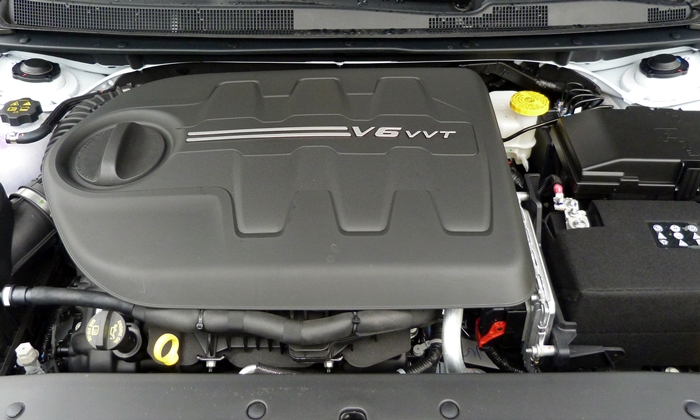
Plain, ugly engine cover.
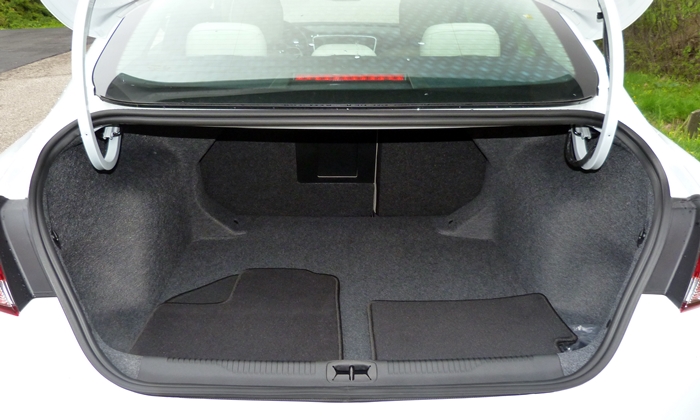
As much trunk space as you'll find elsewhere in the class.
See more 2015 Chrysler 200 photos
Chrysler provided a 2015 200S at a regional media assocation event and later provided a 2016 for a week. Earlier Michael Williams of Southfield Chrysler helpfully provided a 200C for a test drive. He can be reached at 248-354-2950.











